




After the Cowlitz Fisheries Technical Committee approved nearly $4.5 million in grants through the Cowlitz Restoration and Recovery Project aimed at habitat improvements in the Cispus River in a recent meeting, Coastal Conservation Association Chapter President Randy LeDuc was left wondering if anything was being done about hatchery production.
According to LeDuc, smolt returns being tracked at local hatcheries have been low recently, meaning a lot of the fish being released aren’t making it back. LeDuc believes the main issue isn’t lack of habitat but predators.
“We’ve got a big issue with cormorants, sea lions and seals,” LeDuc told The Chronicle. “All of these predators prey on the fish going out as well as coming back, and these are all protected species of animals.”
He said he’s witnessed cormorants gorge themselves on smolt to the point where they can barely fly anymore, and they’re not the only perpetrators.
“The sea lions, they’ll go up to Bonneville Dam and they just set up camp right there where these poor fish are narrowed down to a little funnel and they’d eat until they were sick every day,” LeDuc said.
Because of federal protections for predators, nothing can be done other than pumping up smolt numbers to ensure enough fish survive, according to LeDuc.
Smolt recapture rates at the Cowlitz Falls Fish Facility have been averaging between 25% to 40% throughout most of the summer.
“Of the 700 Chinook released above Cowlitz Falls Dam, 230 have been recaptured at the facility. Of the 600 steelhead released above Cowlitz Falls Dam, 269 have been recaptured at the facility. Of the 900 Coho released above Cowlitz Falls Dam, 253 have been recaptured at the facility,” stated the Cowlitz Falls Fish Facility’s Sept. 5 weekly report.
While habitat loss may play a role in diminishing smolt numbers, LeDuc doesn’t believe it’s the main cause and stated he thinks Tacoma Public Utilities, which runs the Cowlitz Fisheries Technical Committee, doesn’t believe they’re responsible for smolt production going up.
“They have some interesting verbiage here (in the Federal Energy Regulatory Commission, or FERC, Cowlitz License). It said the current upper bound (of smolt production) permitted by the (federal government) is 771,500 pounds, but the production level within the remodeled hatchery will not exceed 650,000 pounds,” LeDuc said.
The difference between what federal legislation permits and what the utility produces is 121,500 pounds, or roughly 600,000 more salmon smolt according to LeDuc.
“Even at just 1% survival, that’s 6,000 more fish,” LeDuc added.
He went on to explain that based on the wording of the Cowlitz license granted by FERC, the Tacoma utility believed it was only responsible for the initial 650,000 pounds of smolt production and doesn’t have to meet the upper bound goals.
“Tacoma interprets it as ‘oh yeah the poundage can go up but we’re not responsible for it,’” and the sportsmen have read it and gone, ‘wait a minute, there’s no other hatcheries in the valley so we think you guys are responsible,’” said LeDuc.
He added the association has taken this issue to U.S. Rep. Jamie Herrera Beutler, R-Battle Ground, who has contacted FERC for clarification. So far, no response from FERC has been given.
The conservation group has recently made some suggestions to Tacoma Public Utilities to aid with increasing hatchery production, including building net-pens for smolt in Mayfield Lake.
“We don’t have the ability to cost it out and submit a budget, so we’re dependent on the agency to do that,” LeDuc said.
He stated he doesn’t have a problem with some of the habitat work, which includes culvert upgrades, but most of the improvements are going to in-stream structures, which he worried could be washed out by flooding.
“It’s very difficult to determine how many additional fish are produced by these in-stream structures,” LeDuc said.
According to the utility, they aren’t concerned with the possibility of habitat improvements being destroyed by flooding. Tacoma Public Utility Natural Resources Specialist Melora Shelton said the organization relies on a variety of input from multiple agencies, both government and private, when making decisions as to where to direct approved funding.
“The technical evaluation that gets done and the process of getting to a recommendation for funding, there’s a full group of technical advisors and look at things like how the project will function on it’s basic design,” Shelton said.
She added that a lot of the habitat improvements were actually being made with flood damage in mind.
“One of the great things about in-stream habitat restoration work is, often, one of the goals of that is to make these habitats more resilient to flooding and high flows,” said Shelton. “To put structure back into streams so the natural habitat processes are more functional.”
She clarified that both the utility and its stakeholders believed habitat restorations would also aid with natural salmon spawning and increase wild populations.
Assistant Power Section Manager Matt Bleich further explained how Tacoma Public Utilities is never alone when making decisions concerning salmon population.
“We think about hatchery production, we think about habitat improvements, we think about fish passage, all the different pieces that go into that,” Bleich said. “One of the things we think about is what is the data we have (does) to inform those decisions, we make those decisions not in a vacuum, we do it with our stakeholders along the way.”
He added that the Cowlitz Restoration and Recovery Project was just one part of what the public utility does to improve fish habitat and populations.
“The (project) is a very important piece that we’ve recently added to our portfolio of how do we make a big difference in the natural production of these fish to rear them in the environment and survive, but it can’t be done alone, it has to be done with all of these other components along the way,” said Bliech. “We look at it continuously as a moving scale with our partners and stakeholders to make the biggest difference that we can at any given moment in time. Honestly, we’re really proud of the fact we have these strong relationships with all of our partners to do this in a way that’s really collaborative.”
The FERC Cowlitz license lists the entities involved with Tacoma in the decision making process, which includes the Washington Department of Ecology and Department of Fish and Wildlife, Washington State Parks and Recreation, American Rivers, the Yakama Nation and Lewis County, among others.
Bliech added that while no new grant money was currently allocated to hatchery production, the utility still invests millions in hatcheries every year. Despite requests for clarification, an exact figure for current hatchery funding has not been provided to The Chronicle.
The public utility has also just announced it is accepting applications for hatchery-related grants, but according to Shelton, the process is still in the preliminary phases and most likely any grant money from those applications won’t be seen until next spring at the soonest.
“It happens that right now we’re going through some higher visibility on the habitat side of things because it’s new, and it’s something we should be really proud of and that we’re doing really good work around. Melora and the others she’s teaming with are doing really good work in that space but that doesn’t mean we’re not doing the other pieces, the other pieces are really important too,” Bliech said.
For information on the Cowlitz Restoration and Recovery Project grants for hatcheries and how to apply, visit https://bit.ly/3WfmtdS or call 253-441-4994.
To view Tacoma Power Utilities’ full FERC Cowlitz license, visit https://www.mytpu.org/wp-content/uploads/original-license-order.pdf. Weekly Cowlitz Fish Report summaries can be found at https://www.mytpu.org/community-environment/fish-wildlife-environment/cowlitz-fish-report/
.